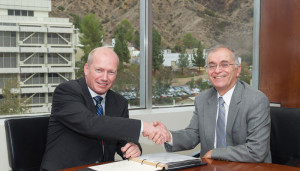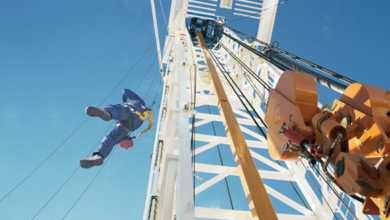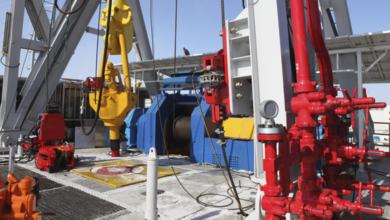Drilling & Completion Tech Digest
Collaboration seeks sustainable water solutions
Baker Hughes and DuPont Chemical Solutions have joined in a strategic arrangement to bring a more sustainable water treatment technology to the industry. Baker Hughes will use the chemical compounds, generators and expertise in chlorine dioxide from DuPont, in conjunction with the H2prO water management service, to augment its pressure-pumping operations.
The use of chlorine dioxide, a compound that is used to treat water, allows for water used in pressure pumping to be treated on-site and reused. In addition to providing chlorine dioxide, DuPont has also provided custom-engineered generators that can be designed to achieve optimal treatment results and can be fitted to Baker Hughes’ treatment trailers.
New technologies double Oseberg field life
Development plans for the Oseberg field in 1983 estimated the reserves at approximately 1 billion bbls of oil. Today, Statoil estimates that recoverable reserves in the main reservoir have increased to 2.6 billion bbls of oil. As a result, the production lifetime of the Oseberg field has doubled, and current plans call for production up to 2040.
New drilling technologies and extensive use of gas injection have made it possible for the recovery rate of the main reservoir on Oseberg to reach a record-breaking 69% with the average world rate of 35%, according to Statoil.
The Oseberg A and Oseberg B platforms also have undergone extensive upgrades, including renovations of the 319 accommodation cabins.

NASA to lend space expertise to oil technologies
By Katie Mazerov, contributing editor
Statoil has forged a partnership with NASA to examine how technologies and expertise from the space industry can benefit oil and gas as it pushes into new frontier regions, such as the Arctic. The agreement, which will run to 2018 with the option of a contract extension, will focus on supercomputing, new materials and tools, robotics and communication, which all relate to today’s downhole technologies, said Knut Rostad, representative for international activities for Statoil. Research efforts under the contract with NASA will be carried out at the California Institute of Technology’s Jet Propulsion Laboratory (JPL) in Pasadena.
The company is planning to commence exploration drilling in the Hoop area in the northern Barents Sea in 2014. It’s also preparing for follow-up exploration offshore Newfoundland, Canada, and in its partnership with Russian operator Rosneft in Arctic Russia, Mr Rostad explained.
The agreement will complement work already under way at Statoil, which spends $550 million annually on research and development, Mr Rostad added. For example, the collaboration could pave the way for new ideas in subsea technology, where Statoil has been an innovator in developing cost-effective and smarter solutions, he said.
“Improving the robustness of subsea technology and other existing technologies are examples of how the JPL/NASA agreement hopefully will play a supplementary role in our stepwise approach in developing Arctic technology. It is our hope that NASA also will benefit from this collaboration,” he said.
Solid expandable system hits 1,500 installations
Enventure has completed 1,500 installations of its SET solid expandable solutions. The 1,500th SET solid expandable system was installed in a well in North Dakota’s Bakken shale.
Drydocks: CJ80 mega jackup to be world’s largest
Drydocks World and Drill One Capital have agreed to build the Dubai Expo 2020 NS mega jackup designed by Gusto MSC. The rig will be able to operate in harsh environments in the Norwegian sector of the North Sea at a maximum water depth of 574 ft (175 meters).
According to Drydocks, the CJ80 jackup will be the largest rig built and the first of its design. The unit will meet all rules and regulations in the Norwegian and UK sectors of the North Sea and will be able to drill to a depth of 40,000 ft (12,192 meters).
The environmentally friendly rig will feature up to 30% less fuel consumption with the use of fuel-efficient technology and up to 25% reduction in emissions compared with similar rigs. The rig also will generate freshwater using waste heat from engine cooling. The jackup is expected to be completed in 2017 and will be equipped with four high-pressure, 7,000-psi mud pumps.
HPHT technologies enable Alder Field development
Chevron North Sea is proceeding with the development of the Alder Field located in Block 15/29a in the Central North Sea, approximately 100 miles (160 km) from the Scottish coast in the UK.
In a water depth of 492 ft (150 meters), development of the Alder field has been enabled by innovative technologies to manage the high-pressure, high-temperature (HPHT) gas condensate. The field will be developed by a single subsea well tied back to the existing Britannia Platform.
The project has a planned design capacity of 110 million cu ft of natural gas and 14,000 bbls of condensate daily. First production is expected in 2016.

Accurate frac placements cut time on Oklahoma well
The Baker Hughes FracPoint multipoint (MP) system with DirectConnect ports has reduced total frac time on a 4,500-ft (1,372-meter) lateral well in Oklahoma’s Mississippian lime shale play by more than 50% compared with a standard plug-and-perf completion that would have taken 30 hours.
The FracPoint MP system uses open-hole packers to isolate zones, and the MP sleeves have patented ball seats that allow one frac ball to open multiple sleeves per stage. The DirectConnect ports are designed to ensure accurate placement of fracture entry points through high-velocity ports that telescope out and impact the formation.
“Baker Hughes treated the well in one continuous pumping operation, and the FracPoint MP system transitioned the operator from the required 40 perforation clusters in its well to 40 total sleeves compartmentalized into nine stages,” said Jeff Kitzman, Baker Hughes region engineer for US Land.
Subsea technology to extend life of Troll B production control system
Recognizing the increased oil recovery opportunities in older fields by inserting new technology, Statoil will use GE Oil & Gas’ SemStar5 Subsea Electronics Module to upgrade and extend the life of the subsea production control system for the Troll B field. The original production system on the field was installed in 1995 with an anticipated 20-year field life. The new system, when delivered in the first half of 2015, will upgrade all wells on manifolds D, E, F, G and H.
The fifth-generation SemStar5 features a modular design and provides infrastructure that supports the higher bandwidth requirements of modern instrumentation.
The first application of the technology was for Statoil’s Tordis Vigdis Controls Modification project in the North Sea, west of Norway, in approximately 656 ft (200 meters) of water.
“GE’s subsea production control system upgrade for Statoil underscores the important role that advanced and ultra-reliable controls technology can play in supporting new and existing offshore production projects,” said Tom Huuse, regional leader – subsea systems services, Nordic region, for GE. “GE’s Subsea Controls and Services team worked closely with Statoil for more than a year to offer its expertise and support Statoil in identifying the optimum, cost-effective solution that minimizes production downtime and provides an expandable controls solution for the future.”
Wireless downhole reservoir testing system provides real-time data
A wireless telemetry system is enabling a new downhole reservoir testing system. Schlumberger recently released the Quartet downhole reservoir testing system, which is enabled by Muzic wireless telemetry. A total of 22 reservoir tests using Quartet have been conducted with data from downhole to surface at a 100% communication success rate.
Separately, the company has deployed the Quartet system on a Petrobras well in the pre-salt Santos basin in Brazil to optimize deepwater well test operations. The system delivered flow and shut-in data to monitor operations and adjust the test program in real time.
The Quartet system provides data in real time for validation and uses wireless bidirectional communication to provide downhole tool status and pressure and temperature data.
Riserless mud recovery system reaches 10 years
AGR Enhanced Drilling’s riserless mud recovery (RMR) system has reached 10 years of operations. The RMR system was first deployed commercially in 2003. It provides a way to return mud and cuttings to the rig before the riser is run and without discharge to the seabed, allowing for engineered, weighted drilling fluid to be used on the top-hole section.
Joint seismic project to explore Barents Sea on NCS
With Statoil as operator, 17 industry companies have established a joint project for planning and implementing the acquisition of seismic 3D data from blocks in the southeastern Barents Sea that will be announced in the 23rd licensing round of the Norwegian Continental Shelf (NCS).
This is the first new area on the NCS to be opened since 1994. When authorities circulate the 23rd round nominated blocks for public consultation, other oil companies will have an opportunity to join the project.
Seismic surveys are expected to start in April 2014 and conclude in the autumn of 2014.
“(Coordinated seismic acquisition) will ensure very good data quality since the industry, to a much greater extent, will be able to utilize the companies’ collective professional expertise within geological understanding and seismic acquisition and processing,” said Gro G. Haatvedt, senior vice president for Statoil’s exploration on the NCS. “The initiative lays the foundation for fewer, well-planned operations, thus reducing acquisition costs and potential disadvantages for the fishing industry.”
Participating companies include Chevron, Eni, GDF Suez, Idemitsu, Lukoil, Norske Shell, PGNiG, Repsol, Suncor, VNG and Wintershall.



